
India-China trade negotiations have restarted following a long break, with signs of cautious optimism on better relations. After being shut in 2020, both countries are exploring ways to reopen critical border trade corridors. Additionally, plans to resume importing local goods are being considered by officials in Beijing and New Delhi. The negotiations take place as a high tariff rate on exports to the US presents challenges for New Delhi.
Will India-China Trade Boost Cross-Border Economic Recovery?
Both nations’ officials are investigating the possibility of reopening particular trading posts along the Himalayan border. Goods such as wool, pottery, spices, and medicinal herbs were traded at a cost of over $3 million each year. These trade centers were therefore vital to communities in remote locations since they held necessities and a means of subsistence.
Four Chinese soldiers and at least 20 Indian soldiers were killed in deadly clashes in 2020. Thus, the pandemic had compelled the trade routes to close at that time. Both parties have since progressively attempted to ease tensions and resume communication. Beijing’s foreign ministry has expressed willingness to deepen communication, highlighting border trade as a key driver of local welfare.
Can New Deals Offset the High US Tariff Rate?
The thaw comes as India faces global trade pressures. The US has increased tariffs to 50%, significantly higher than its regional rivals, which has put further pressure on exports. Chinese officials have stated that they are ready to begin flying between major cities as early as next month. Additionally, some of its export restrictions have been relaxed. These steps are expected to support renewed commercial engagement ahead of high-level meetings in August.
Will India-China Trade Reshape Asian Market Relations?
Restarting India-China trade reflects a recalibration of ties between the two major Asian economies. Therefore, both countries hope that reopening border trade will benefit frontier communities and give markets a sense of stability. The change may have an effect on the Chinese yuan and Indian rupee in the foreign exchange market.
Global risks include US tariff policies, but new trade routes and lowered tensions could encourage capital inflows. Therefore, the planned restart represents a cautious but constructive step in the economic equation for the region.







